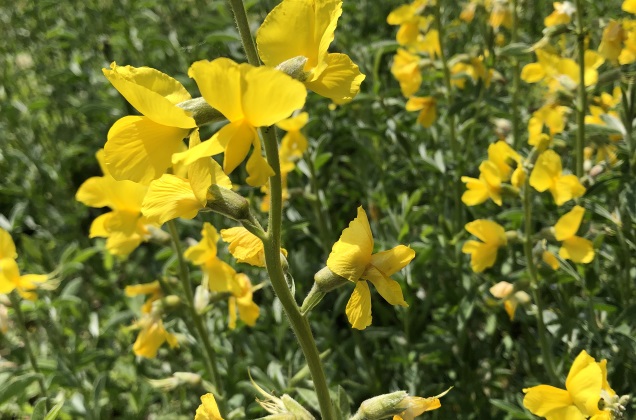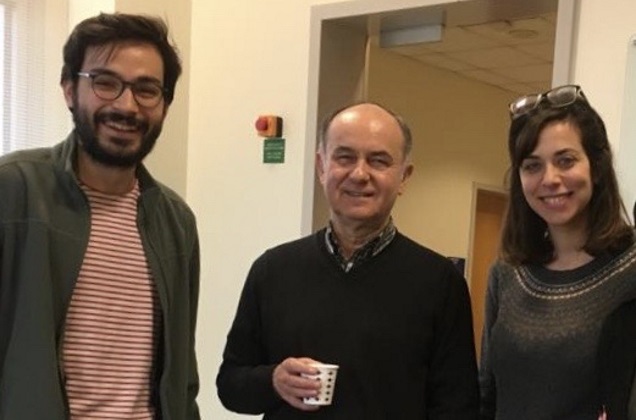25/09/2020
Sabancı University Faculty of Engineering and Natural Sciences (FENS) Faculty Member Selim Çetiner, SUNUM Researcher Stuart J. Lucas, FENS Postdoctoral Researcher Nihal Öztolan Erol, and FENS Molecular Bology, Genetics and Bioengineering graduate student Sezgin Mengi studied the genetic background of a single flower producing several fruit in their study "Using Next-Generation Sequencing for the Full Genome and Transcriptome Analysis of Vuralia turcica.”

The article to be published on Tekfen Tarım about the project is available below.
Vuralia turcica is a species of flowering plants in the legume family, Fabaceae, that is endemic to Turkey and exclusively found in the south of the Eber Lake and southwest of the Aksehir Lake, and has great agricultural promise as it produces several fruit from a single flower. However, global climate change and the change in water regime due to overcultivation has led to the deterioration of the ecosystem in the region. This has led to the areas where Vuralia, a threatened species, grows being placed under protection.

Molecular Bology, Genetics and Bioengineering graduate student Sezgin Mengi, Sabancı University Faculty of Engineering and Natural Sciences (FENS) Faculty Member Selim Çetiner and Project Postdoctoral Researcher Nihal Öztolan Erol
Plants in the Papilionoideae subspecies generally produce a single fruit from a single flower. However, recent research has shown that other plants in this subspecies are also capable of bearing more than one fruit from a single flower. Some examples are Swartzia dipetala of the Swartzia species, and S.microstylis, Aldina diplogyne and Cordyla pinnata (Stergios and Aymard 2008, Paulino, Mansano et al. 2013, Paulino, Prenner et al. 2014, Sinjushin 2018). Bearing several fruit have been observed in the Papilionoideae members Medicago sativa, Medicago truncatula and Pisum sativum due to genetic mutations (Sinjushin 2014).
Vuralia is regarded an economically valuable plant as it is a legume (such as beans, chickpeas, peas and clover) capable of bearing more than one fruit from a single flower. Bakla, nohut, fasulye, bezelye ve yonca gibi ekonomik değeri olan bitkiler ile aynı familyada bulunan Piyan bitkisi, üreme aşamasında bir çiçekten birden fazla meyve vermektedir. Dictated by environmental and genetic factors, this capability may be exploited using advanced agricultural biotechnology to boost the production of crops with a high nutritional value. To this end, Professor Selim Çetiner, Dr. Stuart J. Lucas, Dr. Nihal Öztolan Erol and Genetics and Bioengineering graduate student Sezgin Mengi from Sabancı University, Dr. Dilek Tekdal from Mersin University, and Professor Adil Güner and Dr. Burçin Çıngay from the Nezahat Gökyiğit Botanical Garden supported by the Ali Nihat Gökyiğit Foundation launched the joint project "Using Next-Generation Sequencing for the Full Genome and Transcriptome Analysis of Vuralia turcica to understand the genetic background of multiple fruit production.
Although a threatened species, Vuralia was reproduced through plant tissue culture work undertaken at Sabancı University. The first findings of Vuralia's capability to bear several fruit from a single flower were obtained using next-generation genome and transcriptome sequencing methods. Efforts to determine the functions of genes dictating multiple fruit bearing using the Clustered Regularly Interspaced Shot Palindromic Repeat (CRISPR) method and in-vivo gene editing techniques. This pioneering study will shed light on the aspects of flower development in legumes that remain unknown to date.
Paulino, J. V., et al. (2013). "Elucidating the unusual floral features of Swartzia dipetala (Fabaceae) " Botanical Journal of the Linnean Society 173: 303-320.
Paulino, J. V., et al. (2014). "Comparative development of rare cases of a polycarpellate gynoecium in an otherwise monocarpellate family, Leguminosae." American Journal of Botany 101(4): 572-586.
Sinjushin, A. A. (2014). "Origin and variation of polymerous gynoecia in Fabaceae: evidence from floral mutants of pea (Pisum sativum L.)." Plant Systematics and Evolution 300: 717-727.
Sinjushin, A. A. (2018). "Floral ontogeny in Cordyla pinnata (A. rich.) Milne-Redh. (Leguminosae, papilionoideae): Away from stability." Flora 241: 8-15.
Stergios, B. and G. A. Aymard (2008). "A striking new species of Aldina (Fabaceae-Swartzeae-Aldiniineae) from the Venezuelan Guayana Highlands." Harvard Papers in Botany 13(1): 29-33.




